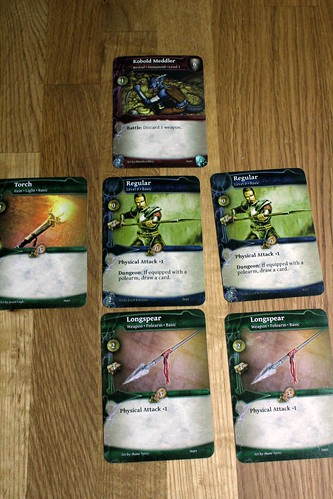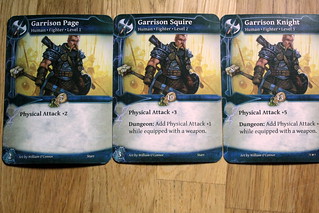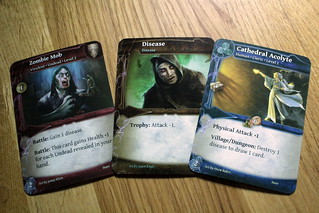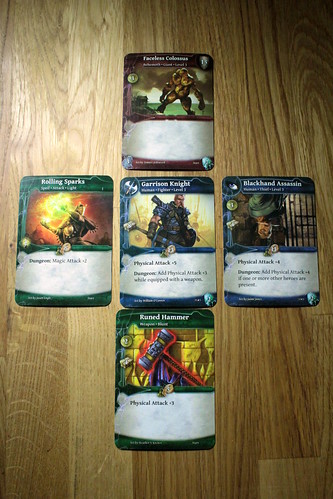| Strategy | Luck |
|---|---|
| Interaction | Components & Design |
| Complexity | Score |

Thunderstone, in all its sets and expansions, is a deck-building game. Before any of the big heroes arrive, you have to defend the village with your starter deck, consisting of Regulars, Longspears, Torches and Thunderstone Shards. That is enough to enter the dungeon and beat up a monster, one of the four actions you can choose on your turn. Regulars are, technically, heroes. But very small ones. Each only adds one point of physical attack, and the smallest monster in the game has three points of health to overcome. Even most of the Level 1 Monsters have five or six points of health, so you need some luck this early in the game. But even your Regulars don’t have to fight unarmed, they can equip weapons. The Longspears from your starting deck will give them an extra +1 Physical Attack, and the Regular’s special ability lets them draw another card when they equip a polearm. That’s actually a vast improvement over previous sets where your basic unit was the Militia, without any sort of special ability. The first few turns each game were utterly boring because you could put down your cards and count if you can defeat a monster or not. The Regular lets you gamble and enter the dungeon with less attack bonus then you need, hoping to draw more fighters or more weapons. Not only that, the Regulars also remain somewhat useful later in the game: if your game has the Bardiche that’s another polearm with a +2 attack bonus, +3 under the right conditions, and your Regulars have enough strength to use it. So you might not always want to remove them from your deck as soon as possible.
The Torches, also included in your How-to-be-a-big-damn-hero Starter Kit, illuminate the dungeon. Dungeons are, by their very nature, dark, and unlike most monsters your troops don’t have night vision. To illuminate a monster near the entrance of the dungeon – the Handbook for Aspiring Heroes calls that in Rank 1 – you only need one point of light, meaning one Torch. A monster in the back of the dungeon – Rank 3 – needs three points of light before you can see it properly. Any point of light you lack gives you a -2 penalty on your attack, so better bring those Torches, especially in the beginning. You can attack monsters on Rank 3 without any interference from the monsters on Rank 1 and 2, by the way. They don’t care. It’s probably some sort of monster prank to just let the heroes pass to attack your monster mates. Just like that time back in high school, when your friend fell asleep in Math class, the teacher startled him awake with a question and you prompted him to answer “The Penis”. Monsters think getting their mates in trouble is hilarious.

Beating a monster lets you take the monster card. It will count as victory points at the of the game. You know the drill, the player with the most points at the end wins the game. Other than that, most monster cards are completely useless and serve to clog your deck. Beating a monster also lets you take XP (experience) tokens, not provided with the game, that will be useful in a moment. The last type of card in your starter deck, the Thunderstone Shards, grant you additional experience and speed up the start of the game somewhat, a slow start being a common complaint about other Thunderstone sets.
But sending your Regulars into the dungeon will only get you so far, and adding useless monster cards to your deck isn’t much of a deck-building game. Sooner or later – actually, sooner – you want to visit the village to upgrade your equipment and higher some Big Damn Heroes™ to be able to take on the dungeons nastier denizens. Spending money in the village is even easier than killing monsters: many cards have a gold value, and the sum of all the values is how much you may spend on one new card. To be clear, you’re not actually removing the cards with the gold from your deck, you’re not really paying with them. They go to your discard pile together with the newly bought card. This is where the deck-building happens, so lets have a look at the different types of cards you can buy. Villagers help you with their special abilities: the Opportunist lets you destroy a Regular, Longspear or Torch for two extra gold, offering easy deck management while giving you some extra cash. The Novice Mage can accompany you into the dungeon and add +1 Magic Attack – but since he’s no hero, he can not equip a weapon. Those two are actually all the Villagers in Thunderstone: Starter Set, but keep in mind that it is just that, a starter set. Like most deck-building games, if you want to keep it interesting, you’ll have to expand.

Also for sale in the village are spells, items and weapons. Spells include the popular attack spell Rolling Sparks (+2 Magic Attack and two points of light) and the support spells Summon Aid (draw two cards, use them if they are Heroes) and Insight (rearrange monsters in the dungeon). In items you get Radiant Orb, a cheap light source that is more efficient than Torches and the Curative Draught, a healing potion that can remove Disease cards from your hand – those are “won” by killing some monsters, mostly the Undead, and reduce your physical attack. Finally, in weapons, I already mentioned the Bardiche, but there are also the Runic Hammer and the Champion Sword, bigger weapons that also need more strength to wield. More strength than your Regulars have. That’s why you want to hire heroes when you visit the village. Well, that and the fact that they are highly trained monster killing machines.
The Heroes represented in this starter set are five classic classes from Dungeons & Dragons, the role-playing game where Thunderstone clearly has its distant roots: Ranger, Cleric, Wizard, Thief and Fighter. All of them start at the same level or slightly stronger than your Regulars, but they can use XP gained from killing monsters to level up. Actually, Regulars can use XP tokens to level up into a Level 1 hero, but that’s not usually a good use for your limited XP, better to buy Level 1 hero cards. A hero can level up to level three, and those High Level Big Damn Heroes™ make a difference in your deck. A Level 1 Wizard, the Tower Apprentice, has a measly +1 Magic Attack and is too weak to even use a Longspear. He’s actually worse than a Regular. At Level 3, as a Tower Master, he has Magic Attach +3 and lets you draw two cards. Other Heroes are more physical in nature: the Fighter at Level 1 – a Garrison Page – has +2 Physical Attack and enough Strength to equip the heaviest weapon in this deck, Champion Sword, with +4 Physical Attack. At Level Three – Garrison Knight – he has +5 Physical Attack and gains another +3 from being equipped with a weapon. If that weapon is a Champion Sword, this guy alone sports +12 physical attack, enough to kill most monters on his own while his companions stand around holding torches and playing the harmonica. But not everyone will employ such a killing machine, there are only two Level 3 cards of each hero class, once those are gone, you won’t find more.
Entering the Dungeon and visiting the Village are the two big actions in Thunderstone, but there are two more, much simpler actions. Resting lets you destroy one card from your hand. It’s a convenient way to rid yourself of a single disease or leftover starter card, but there are more efficient ways to do that. Preparing is a new action in Thunderstone: Starter Set and another change that speeds up the game: when preparing, you may put any number of cards from your hand back on the top of your deck. As you will draw them again right away, in effect you’re discarding only the bad cards from your hand and keeping the good ones, instead of discarding your whole hand after each turn. Older Thunderstone sets often dragged towards the end because no one drew a hand that let him kill those last, big monsters. With preparation, you have better chances and more control in that situation. Sometimes the end still drags, but that’s caused more by inefficient deck-building than bad draws. Thunderstone punishes bad deck decisions hard, because there is nothing at all you can do with a bad hand near the end of the game. Make your deck lean, and be ready to destroy cards when they stopped being useful. Opportunist, I’m looking at you.

The Prepare action and having Regulars instead of useless Militias has resolved two issues I had with other Thunderstone sets: the slow ending and the first few rounds where you didn’t really decide what to do but just let the cards do their thing. As I mentioned above, the slow endings can still be a problem if your deck is too bloated – especially the first few games with all new people can be a pain in the end, but a bit of experience alleviates that. It’s unfortunate that you may have to sit through two or three bad endings before you realize what you were doing wrong, but it does get better. If all you want is a quick dungeon crawl, Thunderstone: Starter Set delivers at that point. But if you’re looking for some depths in your deck building, then this set may be a bit too starter: the most complex card effects are things like +attack for having monsters in your hand, the most difficult thing to consider is whether you can satisfy a monster’s special effect – they may make you discard cards or other such nasty things – and still have enough left to kill it. Worse yet, none of the included cards have any sort of player interaction. That was never one of Thunderstone‘s strongest sides, but other sets had cards that forced opponents to discard when you played them, for instance. Annoying because there was no defense, but not having any sort if interaction is unsatisfying. Thunderstone is not my favorite deck-building game, and while Thunderstone: Starter Set does address the main points that bothered me before, it doesn’t deliver the best experience Thunderstone would have to offer with those changes. Don’t get me wrong, it’s a fun way to kill an hour and a good place to start with Thunderstone, but for longevity and a deeper game, you will have to expand soon.









